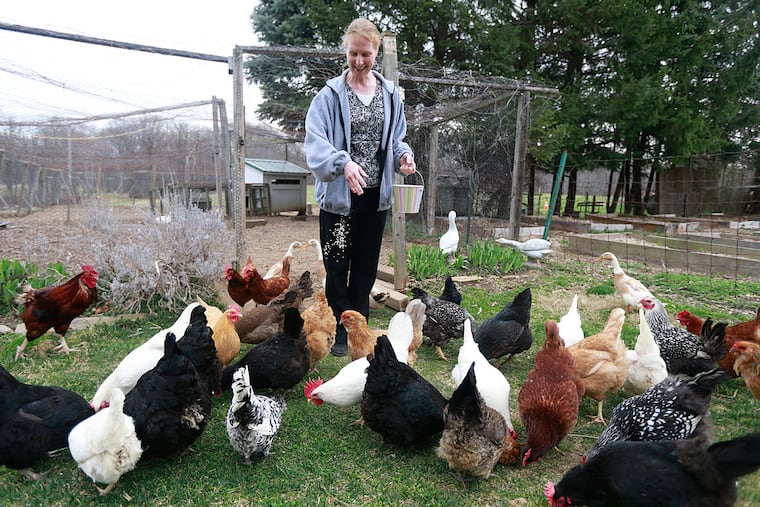Nuns find strength not in numbers, but ideas
Sister Kimberly Kessler has learned the solitary truth about the path she has chosen. She has prayed, studied, and served with the Sisters of the Holy Redeemer in Huntingdon Valley for eight years, with two more to go before taking her final vows. She already has outlasted three other aspirants, who gave up along the way. At age 39 one of the youngest nuns in a community of just 18, she sometimes worries about a future with a dwindling group of sisters to carry on the mission.

Sister Kimberly Kessler has learned the solitary truth about the path she has chosen.
She has prayed, studied, and served with the Sisters of the Holy Redeemer in Huntingdon Valley for eight years, with two more to go before taking her final vows. She already has outlasted three other aspirants, who gave up along the way. At age 39 one of the youngest nuns in a community of just 18, she sometimes worries about a future with a dwindling group of sisters to carry on the mission.
In Kessler, the predicament of religious life crystallizes. Fewer women are answering the call, which tests the creativity of communities to figure out a different way of doing God's business.
"We can say, 'Oh, isn't it sad, our sisters are aging, nobody is coming, we're dying out' - and that's real," said Sister Anne Marie Haas, provincial supervisor of the community's Montgomery County headquarters. "But we have a choice."
At their peak in the 1970s, the Sisters of the Holy Redeemer numbered 150, and were a health-care force in the region, having founded St. Joseph Manor nursing home in 1937 and Holy Redeemer Hospital in 1959.
Now they are crafting a brave future in which the sisterhood may be minuscule, but its work will go on.
After moving last year to more modest quarters nearby, the nuns leased their large motherhouse, off Moredon Road, to Holy Redeemer Health System. The building is being repurposed as a center to train hospital staff in the sisters' holistic approach to health care. They have invited lay people to join a health-system board formerly occupied only by sisters, and they are beefing up the Redeemer Ministry Corps, a group of lay volunteers who work and live with the nuns for 11 months at a time.
"We are looking at, what does a new community look like," Haas said, "and who can be a part of it."
Since 1965, the number of Catholic nuns in the United States has decreased 72 percent, from 181,000 to 50,000. About 90 percent are older than 60, according to the Center for Applied Research in the Apostolate, affiliated with Georgetown University.
While smaller communities feel the loss of even a few members acutely, they often adapt more quickly than larger groups that have more nuns to rely on, said Sister Mary Hughes, director of transitional services for the Leadership Conference of Women Religious, an association of nuns.
The Sisters of the Holy Redeemer was founded in 1849 by Sister Alphonse Maria Eppinger, a frail, sometimes bedridden, French woman who guided her community to offer hope in life's struggles as symbolized by the resurrection of Jesus, Haas said. Today, there are 350 members in Germany, Tanzania, and the U.S.
In 1924, a group of 12 nuns sailed from Germany on the Bremen. In Philadelphia, they served as nurses in the infirmary for employees of the Drueding Leather Manufacturing Co. That property, at Fourth and Master Streets, is now the site of the Drueding Center, a transitional housing and social service agency that the nuns established for homeless mothers and their children.
Sister Sophia Galm, at 86 the local community's eldest member, emigrated from Germany in 1963. She had been an operating room nurse assisting in surgeries on children with facial deformities.
"When the hospital was first built, it was practically all sisters," Galm said. "Now, lay people are doing the work that the sisters started, and that's beautiful to see."
The community also operates a food pantry, an art gallery, and a community garden.
By expanding their ministry beyond the traditional focus on health care, the nuns are hoping to show young people that individual talents and interests can be incorporated into religious life.
Sister Katharina Pies, 40, the community's director of vocations, is increasingly using social media, and planning cookouts and movie nights for young hospital volunteers.
"There are many people who have a deep faith life, but to take the next step into religious life, some are fearful," Pies said.
Sister Ana Dura had no fear. She first thought of becoming a nun in high school. Growing up tending a small vegetable garden and greenhouse with her grandmother, the 40-year-old Dura now runs the Redeemer Valley Community Garden on land adjacent to the former motherhouse, where she raises chickens, ducks, and goats, and supervises more than 40 plots planted by neighbors and students.
"I love this. It's my soul," Dura said. "I feel like I have something to share."
About seven miles away, in Horsham, Sister Linda Arico runs Art at Valley Lake Gallery in a converted office. The gallery hosts exhibits, art lessons, summer camp. Artists who show their work must pledge to lecture, teach, or lead a demonstration.
Arico, a self-taught framer, also offers her services as part of the "Second to Nun Framery." All proceeds from the garden and gallery benefit the ministry.
The sisters' new direction buoys the hopes of the community's oldest member.
"I believe the Redeemer spirit will continue whether we are here or not," Galm said. "But I hope and pray there will always be a sister here - even if it's just one or two."
kholmes@phillynews.com610-313-8211